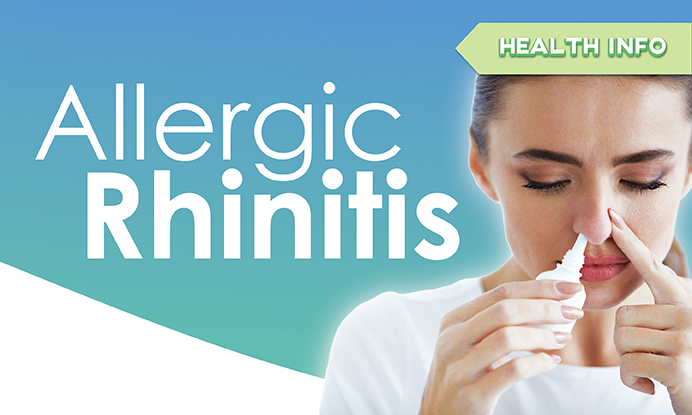
Introduction – What is rhinitis?
- “Rhinitis” means the inflammation of the nose.
- Typical symptoms include nasal congestion, nasal drainage, sneezing, and/or nasal itching.
- Divided into two major groups:
- Allergic Rhinitis
- associated with the allergens including pollens, moulds, dust mites and animal dander, causing inflammation of the nose.
- can be further divided into seasonal, perennial or occupational allergic rhinitis.
- Non-allergic rhinitis
- classified according to the triggers of the rhinitis, generally not due to allergen.
- includes infectious rhinitis (which usually caused by viral infection such as common cold), irritant rhinitis, and others.
- Allergic Rhinitis
Myths versus Facts of Allergic Rhinitis:
- Allergic rhinitis isn’t uncommon – up to fifty percent of the World’s teenagers were already suffering from airway allergies, i.e. allergic rhinitis. An expected seventy to eighty percent of teenagers will be afflicted by airway allergy by the end of this decade with increasing morbidity and mortality if these statistics were extrapolated.
- Allergic rhinitis is possible to develop it at any age – even it is typically presents at a younger age and symptoms are usually happens during young adulthood.
- Allergic rhinitis is not completely harmless – Untreated allergies have a significant impact on quality of life, by resulting in poor quality of sleep, tiredness and lack of concentration when working. It can also worsen other chronic respiratory problems such as asthma and sinusitis.
- Common cold and allergic rhinitis are two entirely different things – even their choice of treatment may be overlapped. Persons with allergic rhinitis might also experiencing ocular symptoms such as itching and redness of the eyes and tearing, which are not happened in viral rhinitis. Other conditions such as sinusitis and nasal polyps may share the same symptoms as allergic rhinitis.
- Pet hair does not cause allergies. Rather, the main culprit is the protein secreted in their skin and saliva that creates the problem. Cats usually cause more allergies than dogs, because they spread the proteins to their coats through grooming.
- Certain treatments can be started before symptoms developed, particularly for seasonal rhinitis, to protect immune system from the assault of pollens.
- Pet hair does not cause allergies. Rather, the main culprit is the protein secreted in their skin and saliva that creates the problem. Cats usually cause more allergies than dogs, because they spread the proteins to their coats through grooming.
- Common cold and allergic rhinitis are two entirely different things – even their choice of treatment may be overlapped. Persons with allergic rhinitis might also experiencing ocular symptoms such as itching and redness of the eyes and tearing, which are not happened in viral rhinitis. Other conditions such as sinusitis and nasal polyps may share the same symptoms as allergic rhinitis.
- Allergic rhinitis is not completely harmless – Untreated allergies have a significant impact on quality of life, by resulting in poor quality of sleep, tiredness and lack of concentration when working. It can also worsen other chronic respiratory problems such as asthma and sinusitis.
- Allergic rhinitis is possible to develop it at any age – even it is typically presents at a younger age and symptoms are usually happens during young adulthood.
Management of Allergic Rhinitis
- Use of second-generation oral H1-antihistamines (e.g. bilastine, loratadine, cetirizine, fexofenadine)
- Aids in allergic rhinitis by blocking the action of histamine that is present in high concentrations during allergic reactions.
- Helps to reduce nasal secretions and relieve eye symptoms such as itching, tearing, redness.
- Possess some, but limited effects of congestions.
- Avoidance of allergen
- Successful treatment of allergic rhinitis should involve allergen avoidances as specific allergens are the main starting point of allergic rhinitis pathophysiology.
- ⇒ When specific sensitization if confirmed and adequate avoidance is possible, precautions such as utilise allergen-impermeable bedding covers for mattress and pillow can be performed.
- Successful treatment of allergic rhinitis should involve allergen avoidances as specific allergens are the main starting point of allergic rhinitis pathophysiology.
- Nasal saline lavage
- Nasal saline lavage using salt water offers minor decongestant benefits and improve clinical outcomes when use in conjunction with oral antihistamines and other pharmacological approaches.
- Works by making the mucus thinner and easier to remove and aids in washing off some of the allergens from the nose that cause irritation.
- Medical devices
- Contain sprays that settled as micro gel layer on the nasal lining, helps to prevent allergens from triggering an allergic reaction.
- May be helpful to neutralise the allergens that is already inside the nose.
- Health supplements
- ⇒ Astragalus root extract
- Works by regulating allergic reactions towards normal immune response and neutralisation of allergen without the onset of allergy symptoms.
- In a study published in the journal Phytotherapy Research, 70% of patient with allergic rhinitis improved significantly after at least two-month of treatment with activated astragalus root extract.
- ⇒ Tiger Milk Mushroom (Lignosus rhinoceros)
- Scientifically proven to be anti-inflammatory, immune-modulating and antiproliferative.
- Key health benefits including relieving of respiratory allergy, helps to repair inflamed tissues and improve respiratory functions.
- ⇒ Probiotics or LAB Fermented Extract
- Allergies could be related to leaky gut syndrome – unbalanced gut flora causing the leakage of harmful bacteria, toxins and undigested food materials into the bloodstream, causing abnormal inflammation and allergic responses.
- Certain strains of probiotics and their extract serves to promote the growth of good bacteria and suppress the growth of harmful types.
- It also works by interact with the host immune system and modify the natural course of allergic disease.
- ⇒ Astragalus root extract
References:
- Tomislav Meštrovi? P. Rhinitis Types [Internet]. News-Medical.net. [cited 25 December 2018]. Available from: https://www.news-medical.net/health/Rhinitis-Types.aspx
- Quillen D, Feller D. Diagnosing Rhinitis: Allergic vs. Nonallergic [Internet]. Aafp.org. 2006 [cited 25 December 2018]. Available from: https://www.aafp.org/afp/2006/0501/p1583.html
- Biggers A. Nonallergic rhinitis: Types, symptoms, and risk factors [Internet]. Medical News Today. 2018 [cited 25 December 2018]. Available from: https://www.medicalnewstoday.com/articles/177085.php
- Rhinitis, Nasal Allergy, Hayfever | AAFA.org [Internet]. Aafa.org. 2015 [cited 25 December 2018]. Available from: https://www.aafa.org/rhinitis-nasal-allergy-hayfever/
- Hoffmans R, Wagemakers A, van Drunen C, Hellings P, Fokkens W. Acute and chronic rhinosinusitis and allergic rhinitis in relation to comorbidity, ethnicity and environment. PLOS ONE. 2018;13(2):e0192330.
- M. Kushnir N, A. Kaliner M, D. Scarupa M. In-Depth Review of Allergic Rhinitis | World Allergy Organization [Internet]. Worldallergy.org. 2015 [cited 25 December 2018]. Available from: http://www.worldallergy.org/education-and-programs/education/allergic-disease-resource-center/professionals/in-depth-review-of-allergic-rhinitis
- Matkovic Z, Zivkovic V, Korica M, Plavec D, Pecanic S, Tudoric N. Efficacy and safety ofAstragalus membranaceusin the treatment of patients with seasonal allergic rhinitis. Phytotherapy Research. 2009;24(2):175-81.
- Astragalus help for allergic rhinitis [Internet]. Star2.com. 2016 [cited 25 December 2018]. Available from: https://www.star2.com/health/wellness/2016/11/06/astragalus-help-for-allergic-rhinitis/#oyMV8oWHBOAGLiPv.99
- Johnathan M, Gan S, Ezumi M, Faezahtul A, Nurul A. Phytochemical profiles and inhibitory effects of Tiger Milk mushroom (Lignosus rhinocerus) extract on ovalbumin-induced airway inflammation in a rodent model of asthma. BMC Complementary and Alternative Medicine. 2016;16(1):167.
- Nallathamby N, Phan C, Seow S, Baskaran A, Lakshmanan H, Abd Malek S et al. A Status Review of the Bioactive Activities of Tiger Milk Mushroom Lignosus rhinocerotis (Cooke) Ryvarden. Frontiers in Pharmacology. 2018;8:998.
- Yang P, Yang G, Liu Z. Treatment of allergic rhinitis with probiotics: An alternative approach. North American Journal of Medical Sciences. 2013;5(8):465.
- Fassio F, Guagnini F. House dust mite-related respiratory allergies and probiotics: a narrative review. Clinical and Molecular Allergy. 2018;16(1).
Tags
Latest Health Info
Healthy Weight, Happy Joints
How Does Weight Affect Knee Health? The Link Between Pounds And Pain Osteoarthritis (OA) involves the degeneration of joints, which ...
The Gut Warriors: Prebiotics, Probiotics and Postbiotics
When it comes to gut health, you’ve probably heard of prebiotics and probiotics. But did you know there’s also ...
Tip Moreh: Masa Berbuka Puasa
Moreh adalah tradisi unik yang biasanya diadakan selepas solat tarawih pada bulan Ramadan. Ia melibatkan penyediaan dan perkongsian makanan ringan ...



